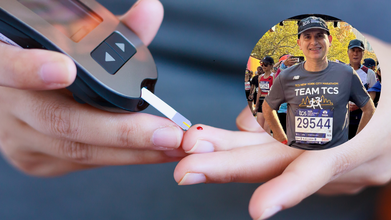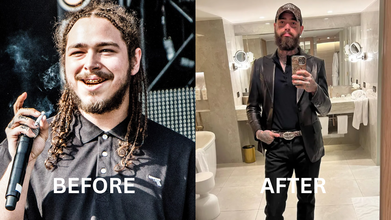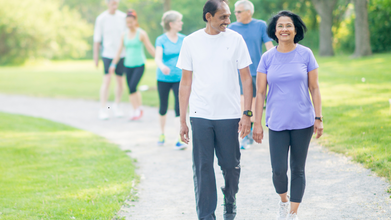- Health Conditions A-Z
- Health & Wellness
- Nutrition
- Fitness
- Health News
- Ayurveda
- Videos
- Medicine A-Z
- Parenting
This Squat Variation Could Help Reverse The Effects Of Sitting All Day

Image Credit: Canva
If you’ve spent hours hunched over a desk or sprawled on a couch, you’re not alone. Modern sedentary lifestyles often leave us with tight hips, weak lower body muscles, and poor posture. But what if one simple exercise could counteract these effects? Enter the humble squat — a powerhouse movement capable of reversing the toll that prolonged sitting takes on your body. Among the many variations, a deep squat, commonly known as the "Asian squat," has become popular for its holistic benefits.
A squat is much more than just a lower-body exercise; it's a movement pattern deeply rooted in human biomechanics. From standing up from a chair to bending down to pick something off the floor, squatting mimics functional actions that are part of daily life. But unlike the limited range of motion associated with sitting, squatting engages multiple muscle groups and joints, including your hips, knees, ankles, quads, glutes, and calves.
Physiotherapists say squatting is the foundation of mobility and strength, especially as we age. Squats challenge balance, coordination, and mobility. They are necessary for everything from standing up to maintaining lower-body strength.
Why Sitting All Day Wreaks Havoc on Your Body?
Prolonged periods of sitting will increase muscle imbalance, stiff joints, and reduced flexibility. Your hip flexors become tight, your glutes become inactive, and slouching at the shoulders will affect your posture. Eventually, this will lead to chronic back pain and other musculoskeletal problems. Deep squats can serve as a counter-effect by loosening tight hip flexors, strengthening the core, and improving lower body stability.
How Deep Squat Is Beneficial?
Compared to the average gym squats, the deep squat focuses on range of motion and joint health. To perform a deep squat:
1. Stand with your feet a little wider than hip-width apart, toes angled out.
2. Chest upright and core engaged.
3. Lower your hips as far as your mobility allows to get the thighs below parallel to the floor.
4. Squat with the position held for a long time, balanced and heels on the ground.
This squat variation builds strength in addition to developing flexibility in your hips and ankles. A deep squat is one of the most natural resting positions that a human body assumes. Many cultures have the habit of adopting it as a way of daily life to eat, rest, or socialize.
Customizing Squat As Per Your Body
Everybody's squat is going to look different. It's about hip anatomy, femur length, and just how comfortable your body feels when you put it in certain foot positions, width, and angles.
If balance or ankle mobility is a concern, try the following:
Heel Raise: Place wedges, plates, or books under your heels to elevate them and make it easier to squat deeper.
Add a Counterbalance: Stand holding a light dumbbell or kettlebell in front of you for more balance.
Provide Support: Lower yourself into a squat while having support from an immovable object such as a chair or a wall.
If you’re new to squats, start with bodyweight squats to build strength and confidence. Gradually incorporate variations like goblet squats, split squats, and single-leg squats to challenge your muscles further. For those aiming to add intensity, weighted squats with barbells or kettlebells can enhance muscle growth and endurance.
Long-Term Benefits of Squatting
It provides many benefits, other than aesthetically appealing, such as better strength of the lower limbs, better posture, increased flexibility, and low chances of injury. The most significant advantage is probably maintaining functional independence into old age. Experts point out that a good lower body strength and mobility are crucial to a long life. Squats make you active, thereby reducing your chances of falls and injuries.
Common Challenges
Has difficulty with depth or coordination? Don't be discouraged. Everyone faces their limitations. Constricting hips, weak ankles, or simply poor balance might limit movement for some. Mobility exercises can address these challenges through ankle stretches or hip openers; practice regularly, and remember, change is slow. Keep an eye on form and control and hold the weight lightly.
You don't need fancy gear or a membership to a gym to incorporate squats into your daily routine. Start with three sets of 10-15 bodyweight squats a day, increase in frequency and intensity as you move forward, and do these squats as part of your warm-up, cool-down, or take them between work to counteract sitting.
So the next time you’re tempted to sink into your chair for hours on end, think about how a few deep squats can reset your body and revitalize your health.
Run To Heal: How A 56-year-old NYC Teacher Ran To Reverse His Diabetes

Credits: iStock, PEOPLE
A New York City teacher Pedro Soto, 56, who teachers at the Manhattan school had a simple sore throat and he believed it was from a viral infection, but it soon turned out to be type 2 diabetes.
This was in April 2024, when he went to his doctor with the complaint of a sore throat and took a blood test. This is when he was "officially diagnosed with type 2 diabetes".
In an interview with PEOPLE, he tells while the doctor recommended medications for him, he was determined to make a lifestyle change first. "After receiving the news, I chose not to start medication right away. Instead, I committed to exercising, running twice a week and improving my diet."
Turns out, running, changed his life.
Running With Diabetes: Soto's Determination To Change His Life(style)
Pedro Soto first considered running the TCS NYC Marathon after a colleague mentioned that her husband had completed it. Motivated, he applied through a special program for teachers, sharing an essay about his type 2 diabetes diagnosis. His story earned him a spot on the team. As he trained, he closely monitored his health, undergoing regular blood tests every three months. The improvement surprised him. His blood sugar levels, once concerning, gradually returned to the normal range. While type 2 diabetes cannot be fully cured, it can be reversed, and Soto was seeing that transformation firsthand.
Training Through The Tough Times
The marathon was scheduled for November 2, 2025. Soto’s training, however, didn’t begin smoothly. In June, he learned he had Lyme disease. Around the same time, he lost his father. Because of these back-to-back challenges, he wasn't able to train consistently until August. Running soon became more than exercise. It became a way to navigate grief and rebuild strength.
He describes those months as emotionally heavy. Running offered him space to reflect, heal, and feel close to his father. It became a ritual that allowed him to confront his feelings rather than avoid them.
Experiencing the Race
To prepare mentally, Soto dove into YouTube videos and articles about the marathon. Still, nothing compared to the real thing. To him, race day felt like a citywide block party. The cheering crowds, music, and energy made the pain more bearable. He said that although the long hours of pounding take a toll on joints and muscles, the city's encouragement kept pushing him forward.
Finding Strength in His Students
The toughest stretch came in the final six miles, when self-doubt crept in. What kept him going was thinking about his students. Soto works with teenagers in a transfer program, many of whom have struggled in traditional school systems. Their perseverance inspired him. If his students could show up every day despite their challenges, he believed he could finish the race.
He says he is taking care of his health and this itself is an act of commitment to his students. Whenever he feels healthier, he shows up as a strong educator and for him the marathon teaches him the importance one needs in life of balance, self-care, and knowing when to put themselves first.
How Post Malone Lost 55lbs Just By Cutting Soda And Ditching Junk

Credits: Canva
"I'm excited for this next chapter in my life, I'm the happiest I've ever been, and for since I could remember I was sad," said Post Malone as he talked about his journey of losing 55 pounds. He went from 240 lbs to 185 lbs, he revealed at The Joe Rogan Experience Podcast. His inspiration? His daughter. He said that he is focused more on his health since becoming a father.
"It is definitely made me take better care of myself. I want to be around to see her go and do kick-*ss stuff. And before, you know, I was really drinking a lot and smoking a lot and stuff. I kind of took everything and toned it down a little bit and, you know, doing my best and really got my weight going," he said.
His weight loss journey started after he welcomed his daughter in May 2022, and on April 20233, he shared on his Instagram that post becoming a father he is now prioritizing his health.
How Did Post Malone Lose So Much Weight?
He said it is simple, he decided to "kick soda and start eating better". He also is trying to cut down his smokes and brews or give up completely, which is taking time.
On his Instagram post, he wrote: "I've had a lot of people ask me about my weight loss and I'd suppose, performance on stage. I'm having a lot of fun performing, and have never felt healthier. I guess dad life kicked in and I decided to kick soda and start eating better so I can be around for a long time for this little angel. Next up is smokes and brews, but I like to consider myself a patient man... lol!"
While his fans were initially concerned about his weight loss, he reassured them that his "brain is in a super dope place" and he was "the happiest" he has ever been in a long time.
When he made his appearance in June 2024, on The Joe Rogan Experience Podcast, he said that his fans in fact, thought, that he started using drugs, due to his drastic weight loss. This is why he posted on Instagram to deny those allegations. “I remember, whenever I started losing my weight, everybody was like, ‘Hey, this is what meth looks like,’ and I started dancing on stage and having fun and having more energy and just enjoying life again, you know what I mean,” he told host Joe Rogan. “Like I mentioned, I was s***** for a long time, but I had my baby and I’m in a great f****** spot and then the first thing that happens is like, ‘Oh he’s on f****** drugs.’"
However, Malone has confirmed that he is not "any hard drugs".
What Helped Malone Lose 55 Pounds?
In an appearance on The Howard Stern Show in October 2023, Malone said that he has not been on weight loss medication, rather he is now making better food choices.
Earlier, whenever he was on tour, he would go for junk, but now, he has made a deliberate choice to eat "grilled chicken" "carrots" with a "little bit of white rice with hot sauce". He said he was blown away to find out that hot sauce has no calories.
He also shared that he has cut out fried food and pizza. He shared that he would previously eat a lot of junk while on tour, especially because those places were open at 2 am after a show. However, when he made those small dietary changes, he lost 20 pounds, which made him think "let's keep building".
He also shared that he started cutting down on his soda intake. However, he would occasionally reward himself with one after a show.
He also showed off his weight loss in an August 2023 Instagram post on a mirror selfie and wrote: "Introducing Viceroy Chungus VonBattlepass, i love you," in caption.
Cannot Hit 10,000 Steps A Day? A Short Stroll Too Could Make You Healthy

Credits: Canva
For years, the idea of walking 10,000 steps a day has been treated like universal fitness wisdom, however, a recent study reveals that even a short stroll too could help you stay healthy.
From fitness trackers to morning-walk groups, the number has been repeated so often that many people believe it is a scientifically proven rule. The truth is far simpler and far more encouraging. New research shows that you do not need anywhere near 10,000 steps to improve your health. In fact, even a small amount of regular movement can dramatically lower your risk of heart disease and early death.
What Recent Research Reveals
A new study published in the British Journal of Sports Medicine examined how step counts influence longevity and heart health, particularly in older adults. The findings were surprisingly optimistic. Scientists discovered that walking as few as 4,000 steps in a day, even if you manage this number only one or two days a week, can reduce the risk of death by 26 percent. It can also lower the risk of heart disease by 27 percent when compared to those who barely moved.
The benefits became even more striking when participants achieved the 4,000 step target on more than three days per week. In that group, mortality dropped by more than 40 percent and the risk of heart issues fell by 27 percent. These numbers show that moderate, regular walking has powerful protective effects on long-term health.
How Many Steps Do You Really Need
The study also explored whether aiming for higher step counts brings additional benefits. Researchers found that walking around 7,000 steps a day provides a slight extra advantage when it comes to living longer. However, it does not significantly change cardiovascular outcomes. This means that hitting 4,000 steps is already enough for meaningful protection, especially for older adults or people who are unable to reach higher counts.
Interestingly, the study also revealed that the number of days you walk matters far less than the total steps collected throughout the day. When scientists adjusted for total daily steps, the link between how many days people walked and their health results disappeared. The real takeaway is this: what matters most is how much you move overall, not whether you meet a daily or weekly quota.
Why Consistency Matters More Than Intensity
Walking is one of the simplest forms of movement, yet its benefits are remarkably wide-ranging. It is gentle, low impact and accessible to almost everyone. Regular brisk walking has been shown to improve heart health, support weight management, boost mental well-being and improve mobility. These improvements occur because consistency helps the body adapt, even when the total effort seems small.
For older adults, or for anyone returning to activity after a long pause, this consistency is especially important. Small, steady efforts accumulate and gradually build up stamina. Over time, this reduces the risk of chronic disease and enhances overall fitness without stressing the joints.
Tips To Make Walking A Sustainable Habit
If you want to enjoy the health benefits of walking, the key is to stay consistent rather than chase big numbers. A few practical tips can help you build a routine that feels realistic and enjoyable.
Start slowly
If you have been inactive for a while, begin with five to ten minutes of walking at a comfortable pace. Gradually increase your duration and distance over several weeks. This prevents strain and reduces the risk of giving up too soon.
Set achievable goals
Aim for manageable targets such as walking 20 to 40 minutes three days a week. Once this feels comfortable, you can add more time or increase your frequency if you wish.
Adjust your routine when life gets busy
If you are traveling or have long work hours, try breaking your walks into shorter chunks. A few five to ten minute walks throughout the day can help you stay on track.
Do not let the weather stop you
When outdoor conditions are not ideal, choose indoor spaces such as malls, gyms, community centers or even long corridors at home or work.
Add variety to your routes
Different routes help fight monotony and make walking more enjoyable. Rotate between parks, neighborhoods or indoor spaces to keep things fresh.
© 2024 Bennett, Coleman & Company Limited

